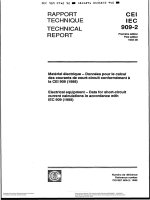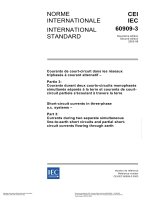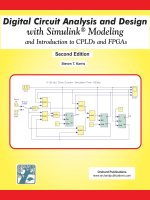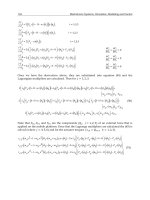4 short circuit modeling
Bạn đang xem bản rút gọn của tài liệu. Xem và tải ngay bản đầy đủ của tài liệu tại đây (376.54 KB, 14 trang )
Power Systems & Energy Course:
Modeling Renewable Plant Short Circuit
Current Contributions
Jason MacDowell
Background
• Short-circuit analysis is necessary for:
– Protection coordination
– Assessment of fault-current withstand requirements
• Industry’s short-circuit analysis practices and tools based on
synchronous generators
– Positive sequence represented by an ideal voltage source behind
reactance
– Negative sequence represented by a simple constant reactance
• Older wind turbines (Type 1 and 2) are generally compatible
with existing short circuit analysis practices and tools
• Modern wind turbines and PV inverters are not
– Modern WTGs use variable-speed generators
– Doubly-fed asynch. generators (DFAG, aka DFIG) – Type 3
– Full ac-dc-ac conversion – Type 4
– PV inverters are like Type 4 wind turbines
© 2016 General Electric International, Inc. All rights reserved. Not for distribution without permission.
10-2
Type 1 WTG (Squirrel Cage Induction Generator)
Source: V. Gevorgian and E. Muljadi, “Wind Power Plant
Short Circuit Current Contribution for Different Fault and
Wind Turbine Topologies”, 9th Annual International
Workshop on Large-Scale Integration of Wind Power into
Power Systems as well as on Transmission Networks for
Offshore Wind Power Plants, Québec, Canada
October 18-19, 2010
• WTG can be a substantial short-circuit source for the initial cycles
– Three-phase fault causes rotor flux to collapse
– Current contribution drops accordingly
© 2016 General Electric International, Inc. All rights reserved. Not for distribution without permission.
10-3
Type 2 WTG (Wound Rotor Induction Generator)
Source: V. Gevorgian and E. Muljadi, “Wind Power Plant
Short Circuit Current Contribution for Different Fault and
Wind Turbine Topologies”, 9th Annual International
Workshop on Large-Scale Integration of Wind Power into
Power Systems as well as on Transmission Networks for
Offshore Wind Power Plants, Québec, Canada
October 18-19, 2010
• Added rotor resistance causes ac decrement to be faster than dc
decrement
– WTG short-circuit contribution may not have current zeroes until a number of cycles
following a three-phase terminal fault
– Fault resistance and grid short-circuit contribution tend to make the absence of current
zeroes not a major practical issue
© 2016 General Electric International, Inc. All rights reserved. Not for distribution without permission.
10-4
Modeling Type 1 and 2 Induction WTGs
• Models for induction machines are provided in most
commercial short-circuit analysis software tools
• Fundamentally the same as a synchronous generator model,
but without the field excitation
• Parameters of the model are based on the physical
characteristics of the rotating machine
© 2016 General Electric International, Inc. All rights reserved. Not for distribution without permission.
10-5
Fault Behavior of Type 3 and Type 4 WTGs & PV
Design objectives:
• Protect the equipment
• Ride through the fault
• Provide grid support, as required
Comparison with synchronous generators:
• Synchronous generator fault performance established by fundamental
physics
– Little qualitative difference from one generator to another
– One model structure applies to all
• Type 3 and 4 wind turbine, and PV inverter, fault performance governed
by control design
– Wide variations in control techniques
– Voltage behind reactance does not work well as a model
© 2016 General Electric International, Inc. All rights reserved. Not for distribution without permission.
10-6
Type 3 WTG (Doubly Fed Generator)
3-ph Fault to 20% Voltage
• Initially, rotor circuit is “crowbarred” – acts like an induction generator
– symmetrical current up to ~ 4 p.u.
• As fault current decreases, crowbar is removed
• Current regulator regains control
© 2016 General Electric International, Inc. All rights reserved. Not for distribution without permission.
10-7
DFG Crowbar Protection
• Severe fault induces high voltage on rotor
• Some form of “crowbar” needed to divert induced current
– Chopper on dc bus
– Shorting device on rotor circuit
– Bypass through converter bridge
• Results in highly discontinuous fault behavior
– Substantial complication of short-circuit modeling
• Crowbar initiation and removal thresholds vary with design
© 2016 General Electric International, Inc. All rights reserved. Not for distribution without permission.
10-8
Operational Behavior of Type 4 WTGs
and PV Inverters
• Voltage-source converter (VSC) is controlled to regulate
current
– Current regulator has high bandwidth
– Essential to protect sensitive IGBTs
– WTG/Inverter is thus a virtual current source
• Real and reactive output current can be independently
controlled
• Grid performance virtually independent from characteristics
of physical generator
© 2016 General Electric International, Inc. All rights reserved. Not for distribution without permission.
10-9
Type 4 WTG Short Circuit Current
3-ph Fault to 20% Voltage
• Initial transient current – ~ 2 p.u. symmetrical
• Current regulator quickly takes control
• Current order increased for grid support in this design
© 2016 General Electric International, Inc. All rights reserved. Not for distribution without permission.
10-10
Unbalanced Faults
• Necessary to limit current magnitude of each IGBT in
bridge
– Positive and negative sequence behavior is not decoupled
as in a synchronous generator
– Simple sequence component-based analysis cannot be
accurate
• Active limitation of negative sequence current
commonly used in both Type 3 and Type 4
– Negative sequence “bucking” may be nonlinear
– Negative sequence does not appear like a passive
impedance
© 2016 General Electric International, Inc. All rights reserved. Not for distribution without permission.
10-11
Modeling Type 3 & 4 WTGs, and PV Inverters
in Short Circuit Studies
Alternative #1: approximate modeling
• Type 3
– Model as a voltage source behind subtransient reactance
– Provides upper limit to short-circuit current
• Type 4 and PV Inverter
– Model as a current-limited source
– Current magnitude 2 – 3 p.u. for first 1 – 2 cycles
– Longer-term current could be from pre-fault value to ~1.5 p.u.,
depending on control
Approximate models are quite inexact, but may be good enough because WTG
contribution to grid fault current is usually much smaller than total
Inadequate where wind plant current contribution is dominant, and accuracy
is important
© 2016 General Electric International, Inc. All rights reserved. Not for distribution without permission.
10-12
Modeling Type 3 & 4 WTGs, and PV Inverters
in Short Circuit Studies
Alternative #2: detailed time-domain simulations
• Performed in an EMT-type program (EMTP, ATP, PSCAD, etc.)
• Requires detailed hardware and control model
– Such data are usually considered quite proprietary
– “Generic” models are quite meaningless
• Not well suited for large system studies
• Requires an expertise different from that of most short-circuit program
users
• Considerable computational effort for each case
Technically superior alternative,
but generally quite impractical.
© 2016 General Electric International, Inc. All rights reserved. Not for distribution without permission.
10-13
Modeling WTGs in Short Circuit Studies
Alternative #3: modified phasor approach
• Wind turbine manufacturer provides tables or graphs of current versus
residual fault voltage for certain times
• Network short circuit analysis solved iteratively
Upper Limit
Current
Fault
Lower Limit
Residual
Voltage
Type 3 W TG
Fault Current at 3 cycles
Most feasible option at this time;
short circuit software needs to be modified
© 2016 General Electric International, Inc. All rights reserved. Not for distribution without permission.
10-14









